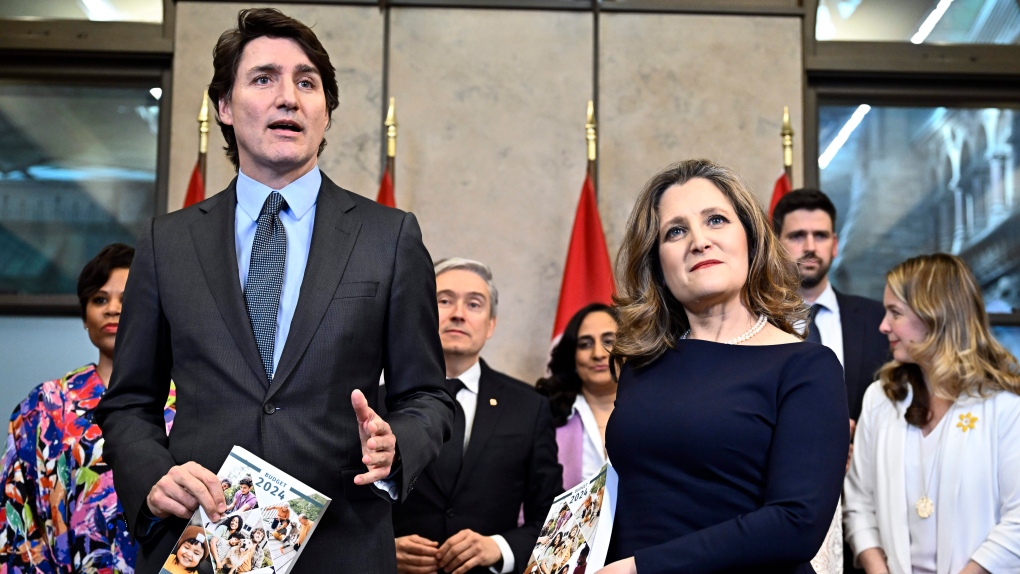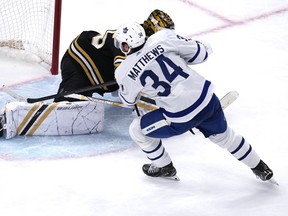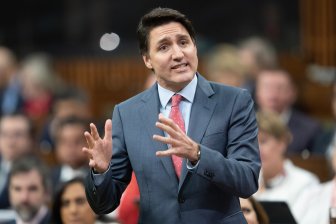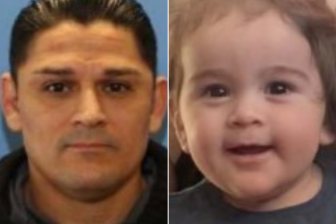News
Coronavirus: What's happening in Canada and around the world on Wednesday – CBC News
The latest:
New Brunswick’s health minister is asking the public for assistance as the province struggles with a growing wave of COVID-19 that has sparked concern over the strained health-care system.
“We need your help,” Dorothy Shephard, the province’s health minister, said in a statement. “Whether you are retired, non-practising or unlicensed — if you have experience that can help, please reach out to us.”
The health minister said the Omicron variant is causing both increased hospitalizations and staff absences, which is “putting pressure on all aspects of our health-care system.”
Health officials in New Brunswick on Tuesday said three more people who had COVID-19 had died, bringing the number of recorded deaths in the province to 192. The province also said a total of 113 people were hospitalized with COVID-19, including 15 in intensive care. The province, which is one of many jurisdictions in Canada that now restrict access to PCR testing, also reported an additional 330 lab-confirmed cases.
The province said it was looking for people to fill both paid and unpaid roles, noting in the statement that training and personal protective equipment would be provided.
New Brunswick’s call for help came as Prince Edward Island announced tight new restrictions — including closing gyms and restaurant dining rooms — and extended remote learning until the end of January as officials try to slow the spread of COVID-19.
As of Tuesday, the island had eight people in hospital being treated for COVID-19, including four in intensive care. The province also reported an additional 407 lab-confirmed cases.
New restrictions: <br>- personal gathering limited to a single household + 2 support ppl, those who live alone may join other household<br>- no organized gatherings<br>- funerals/weddings capped at 10 <br>- gyms, rec activities closed<br>- no dining in restaurants
—@nicolammacleod
Nova Scotia on Tuesday reported one additional COVID-19-related death. Health officials said in a statement there were 73 people in hospital “who were admitted due to COVID-19 and are receiving specialized care in a COVID-19 designated unit.” That figure includes 15 people being cared for in intensive care units, the province said.
The update came as the province reported an additional 415 lab-confirmed cases of COVID-19.
“Now is the time to buckle down,” Premier Tim Houston said in a statement. “I ask all Nova Scotians to do everything you can to keep COVID-19 out of our health-care system, long-term care facilities and our communities.”
In Newfoundland and Labrador, health officials on Tuesday reported two additional deaths and said COVID-19 hospitalizations in the province stood at 14, with three people in critical care. The province also reported an additional 295 lab-confirmed cases of the illness caused by the novel coronavirus.
-From CBC News, last updated at 7:20 a.m. ET
What’s happening elsewhere in Canada


With lab-based testing capacity deeply strained and increasingly restricted, experts say true case counts are likely far higher than reported. Hospitalization data at the regional level is also evolving, with several provinces saying they will report figures that separate the number of people in hospital because of COVID-19 from those in hospital for another medical issue who also test positive for COVID-19.
For more information on what is happening in your community — including details on outbreaks, testing capacity and local restrictions — click through to the regional coverage below.
You can also read more from the Public Health Agency of Canada, which provides a detailed look at every region — including seven-day average test positivity rates — in its daily epidemiological updates.
In Central Canada, Ontario health officials reported an additional 60 deaths on Wednesday, as the province’s health minister held a COVID-19 briefing alongside the province’s top doctor.
Health Minister Christine Elliott reported a total of 4,132 hospitalizations, with 589 in ICU. A total of 5,744 additional lab-confirmed cases were reported in Ontario on Wednesday, which was the first day back in classrooms for many students after a winter storm delayed the shift to in-person education.
82% of patients admitted to the ICU were admitted for <a href=”https://twitter.com/hashtag/COVID19?src=hash&ref_src=twsrc%5Etfw”>#COVID19</a> and 18% were admitted for other reasons but have tested positive for COVID-19.<br><br>Individuals who are fully vaccinated represent 78.5% of Ontario’s total population and account for 224 of Ontario’s 589 ICU admissions.
—@celliottability
Dr. Kieran Moore, Ontario’s chief medical officer of health, said Wednesday that for the first time in weeks, the number of people in the province’s hospitals and intensive care units is “increasing at a slower pace.”
Elliott said she sees a glimmer of hope, but cautioned that February will pose a challenge — especially for hospitals.
Quebec’s COVID-19 update on Wednesday showed 88 additional deaths. Hospitalizations stood at 3,425, with 285 people in intensive care units. The province also reported an additional 6,123 lab-confirmed cases.
“In all likelihood, the number of cases has already peaked,” Dr. Luc Boileau, Quebec’s interim public health director, told reporters on Tuesday. “We’re starting to see the rise in hospitalizations slowing down, which is a very good sign, even if the situation in hospitals remains very fragile.”
In the North, the chief public health officer in the Northwest Territories on Tuesday said restrictions on gatherings were being extended until the end of the month. A statement from Dr. Kami Kandola said additional recommendations are being made for Inuvik and Fort Smith, including a call for work-from-home where possible, because of community transmission.
In the Prairie provinces, Manitoba on Tuesday reported three additional deaths in its COVID-19 update. The total hospitalizations stood at 620, with 48 in intensive care. The province also reported an additional 847 lab-confirmed cases.
In Saskatchewan, there were no additional COVID-19-related deaths reported on Tuesday. According to the province, the total number of hospitalizations increased to 189, with 18 people in intensive care units. The province also reported an additional 1,089 lab-confirmed cases.
Meanwhile, Alberta’s chief medical officer of health said COVID-19 hospitalization rates are rising to levels not seen in the province since mid-October when the health-care system was grappling with the fourth wave. Dr. Deena Hinshaw said the surging number of cases driven by the highly infectious Omicron coronavirus variant are starting to be reflected in hospital admissions.
As of Tuesday, the province’s COVID-19 updates showed a total of 1,089 hospitalizations, with 104 people in intensive care units. The province also recorded nine additional deaths and 3,279 additional lab-confirmed cases.
“It is important to recognize that any COVID-positive admission has an impact on our acute-care capacity,” Hinshaw said, as she outlined changes to how the province will report data on COVID-19 patients. “The bottom line is that our acute-care system remains under serious pressure and COVID-19 continues to pose a risk of severe outcomes to many Albertans.”
Gyms and other exercise facilities are being allowed to gradually reopen in British Columbia, a move the province’s top doctor describes as a “cautious step” in lifting COVID-19 restrictions. Dr. Bonnie Henry said proof of vaccination will be required to use gyms, which will operate under capacity limits.
Henry said other restrictions that went into effect in December will remain in place because of the high rates of transmission and the number of people needing hospital care. Bars and nightclubs will stay closed and capacity limits for restaurants, theatres and stadiums will remain in place until Feb. 16.
The province on Tuesday reported a total of 854 COVID-19 hospitalizations, including 112 in intensive care. The province also reported nine additional deaths and 2,032 lab-confirmed cases.
-From CBC News and The Canadian Press, last updated at 11:15 a.m. ET
What’s happening around the world
With just days before hundreds of athletes, coaches and staff depart for the Beijing Winter Olympics, CBC News has learned that China’s COVID-19 testing threshold is so high, it may prevent some athletes from competing — even if they’ve been previously cleared of the virus. 2:54
As of early Wednesday morning, roughly 334.4 million cases of COVID-19 had been reported worldwide, according to Johns Hopkins University’s coronavirus tracker. The reported global death toll stood at more than 5.5 million.
In Europe, France has registered 464,769 new COVID-19 infections over the last 24 hours, official data showed on Tuesday, the highest-ever recorded tally since the start of the pandemic.
In the Asia-Pacific region, the United Nations is preparing for distanced relief operations in Tonga to avoid a COVID-19 outbreak in the Pacific island nation that is reeling from the impact of a volcanic eruption and tsunami, an official said.
In Africa, Namibia’s pandemic-ravaged tourism sector launched a campaign to encourage its employees to get inoculated as vaccine hesitancy threatens to derail the sector’s revival.
Meanwhile, South Africa reported 3,658 additional cases of COVID-19 on Tuesday and 100 additional deaths, though officials noted 30 of the deaths occurred in the previous 24 to 48 hours.
Due to the ongoing audit exercise by the National Department of Health (NDoH), there may be a backlog of COVID-19 mortality cases reported. Today, the NDoH reports 100 deaths and of these, 30 occurred in the past 24 – 48 hours. This brings the total fatalities to 93 551 to date.
—@HealthZA
In the Americas, the U.S. government’s new COVIDTests.gov website, set up for American households to order four free COVID-19 tests amid the Omicron variant surge, is up and running ahead of its official launch on Wednesday, the White House said.
In the Middle East, Iran on Tuesday reported 19 additional deaths and 4,060 new cases of COVID-19.
-From Reuters, CBC News and The Associated Press, last updated at 7:25 a.m ET
News
What is a halal mortgage? How interest-free home financing works in Canada – Global News
The federal government is looking at making Islamic home financing increasingly accessible to help more Canadians break into the housing market.
As part of the 2024 federal budget that was released last week, Ottawa said it is “exploring new measures to expand access to alternative financing products, like halal mortgages.”
Last month, the federal government started consulting financial services providers and communities to understand how policies can better support the needs of all Canadians seeking home ownership, according to the budget.
“Canada is home to a vibrant and growing market of alternative financing products, including halal mortgages, that enable Muslim Canadians, and other diverse communities, to further participate in the housing market,” the budget states.

Currently, none of Canada’s big six banks offer halal mortgages, which are an interest-free payment structure that follows Islamic principles.
However, some lenders in Canada have been offering halal mortgages for several years now.
“Halal mortgages are already offered to all Canadians by financial institutions,” Caroline Thériault, a spokesperson for the Department of Finance, said in an emailed statement to Global News Tuesday.
Thériault said halal mortgages are not government of Canada products.
“The government is simply looking at ways to help more Canadians become homeowners, while ensuring adequate consumer protections are in place.”
What is a halal mortgage?
A halal mortgage is a real estate financing method that complies with Islamic principles and teachings.
Under Sharia law, it is forbidden for Muslims to receive and pay interest, so a halal mortgage essentially takes interest out of the equation.
Instead, the mortgage is based on the principle of profit, said Mohamad Sawwaf, founder and CEO of Manzil, a Canadian financial institution that offers Sharia-compliant services.
Manzil has been offering halal mortgages that are both partnership- and profit-based since 2020.
“We look at this product as an innovation within the Canadian mortgage marketplace to allow for a segment of the population and the broader ethical community that may want to participate,” Sawwaf said in an interview with Global News Monday.
The end result of homeownership is the same, but the process and documentation are different compared with a regular mortgage, he said.
“Within the Islamic finance principles, you’re acquiring a real asset, it’s commodity-based, and then you are reselling it or partnering in that asset long-term, so that is the key difference here.”

Victor Tran, a mortgage and real estate expert at Ratesdot.ca and broker with True North Mortgage, said a halal mortgage is almost like a traditional mortgage where the lender and the homeowner have shared ownership of the property, but there are extra steps involved.
He said the difference is that “instead of charging interest to the homeowner, the contract is structured in a way where there’s a fee charged.”
Even though halal mortgages are interest-free, it doesn’t mean the lending happens at a zero per cent charge, Sawwaf said.
“It just means that you’re not part of a transaction where money is being lent and you have to pay more money back,” Sawwaf said.
“That is the principle of usury within Islam and other Abrahamic faiths that we’re trying to avoid.”
Usury, which is the lending of money at exorbitant interest rates, is also prohibited in Judaism and Christianity.
Types of halal mortgages
Halal mortgages in Canada fall under three different types of agreements, called Ijara, Murabaha and Musharaka, according to Rates.ca.
Ijara is like a rent-to-own agreement in which the inhabitant of the home starts as a renter and becomes the owner upon final loan payment, Tran said.
Under this type of financing, the home is purchased by a trust, which then leases it to the customer.
The Murabaha is a cost-plus financing structure in which an Islamic financial company becomes the owner of a home and sells it to their client for a price that includes a profit rate, which is benchmarked against the Bank of Canada’s overnight lending rate, Tran explained.
The client enters into a purchase agreement that specifies fixed monthly payments for the duration of the contract, which is usually up to 15 years.

Under the Musharaka arrangement, an Islamic financial company and its client become co-owners of a home, Tran said.
Throughout the mortgage term, which will follow the traditional mortgage term of up to 25 to 30 years, the financial company’s equity position decreases and the customer’s equity position increases proportionately as they pay out the owned balance.
At the end of the contract, the client will have 100 per cent home ownership and the company will have zero per cent, Sawwaf said.
Financial pros and cons of halal mortgages
From the financial standpoint, one of the main benefits of halal mortgages is that it introduces a long-term fixed mortgage rate, Sawwaf said.
For instance, under the Murabaha agreement, which follows the buy-and-sell structure, the mortgage can run up to 10 to 25 years.
Sawwaf said because the lender is sharing in the long-term risk, halal mortgages are “much more ethical and valuable at the end of the day” as opposed to having a debt-based system that is “not really good for society and its long-term social impact.”
However, the downside is that the costs of halal mortgages are higher because the lenders are not able to access low-cost capital, Sawwaf said.
“We’re hoping that the government signalling that they’re in support of halal mortgages with respect to potential legislation or policy changes, this could allow us to tap into institutional capital at the banks or other institutions,” he said.

Tran said because the costs and fees are a little bit higher for a halal mortgage than a traditional mortgage, it may not be a financially feasible option for many.
Among the measures that Ottawa is exploring are changes in the tax treatment of halal mortgages or a new regulatory sandbox for financial service providers.
Who can apply for a halal mortgage?
Anyone in Canada, Muslim or non-Muslim, can apply for a halal mortgage, which is currently offered by a few financial institutions.
“Everyone is allowed to have a halal mortgage no different than you can go to any restaurant and eat a shawarma with halal chicken in it,” Sawwaf said.
“We don’t care what your background is, your religion, your creed, even if you’re non-religious or an atheist.”
As for the down payment, most lenders in Canada require clients of halal financing to pay a minimum of 20 per cent of the market value, or purchase price, of the house.
Customers should also have a good credit history and sufficient income to meet the monthly payment obligation, the Canadian Halal Financial Corporation says.
More on Money
News
Amid concerns over 'collateral damage' Trudeau, Freeland defend capital gains tax change – CTV News


Facing pushback from physicians and businesspeople over the coming increase to the capital gains inclusion rate, Prime Minister Justin Trudeau and his deputy Chrystia Freeland are standing by their plan to target Canada’s highest earners.
In respective press conferences on Tuesday, both Trudeau and his finance minister defended their proposal to rake in $19.3 billion over the next five years by increasing the capital gains inclusion rate — the portion of capital gains on which tax is paid – for individuals with more than $250,000 in capital gains in a year.
This new revenue stream comes as the federal government plans to spend billions of dollars to increase Canada’s housing supply and enhance social programs, with the Liberals framing the new revenue as helping to offset those investments in a way that’s fair and doesn’t offload a larger deficit on younger generations.
“At a time when young people have started to give up on the dream of eventually ever being able to own a home, it was really important to rebalance the situation,” Trudeau said, speaking to reporters in Saskatchewan.
“I understand for some people this may cost more if they sell a cottage or a secondary residence. But, young people can’t buy their primary residences yet.”
What is the capital gains tax change?
As revealed in last week’s federal budget, the capital gains inclusion rate will increase from 50 per cent to 67 per cent, and will also apply to all capital gains realized by corporations and trusts.
That means that as of June 25, people with more than $250,000 in profit made on the sale of assets in a year will have to pay taxes on a larger portion of that money.
This incoming amendment to the Income Tax Act is expected to affect the wealthiest 0.13 per cent, and approximately 12 per cent of Canada’s corporations and Canadians with an average income of $1.42 million.
The inclusion rate for capital gains realized annually up to $250,000 is not changing, the existing capital gains exemption on primary residences will remain, and the lifetime exemption limit for small business shares, as well as farming and fishing properties is increasing.
What is the criticism?
While not the direct wealth tax or excess profit taxes some had anticipated – given Freeland’s dodging of questions about whether those were revenue routes the government was considering – since the budget was tabled, many Canadian business owners and entrepreneurs have raised concerns that the move could stunt innovation.
“At a time when our country is facing critically low productivity and business investment our political leaders are failing our country’s entrepreneurs,” wrote Shopify president Harley Finkelstein in a post on “X” last week.
On Tuesday, the Canadian Medical Association (CMA) also came out against the move, asking the Liberals to reconsider as the change will impact doctors’ retirement savings as most incorporate and operate their practice as a small business.
“It is completely unfair, late in the game taxation for those physicians who did follow the rules of the day and save for their retirement inside of our professional corporations,” CMA president Dr. Kathleen Ross said Tuesday.
PBO cautions ‘collateral damage’
It’s this kind of potential for “collateral damage” that Canada’s Parliamentary Budget Officer Yves Giroux voiced caution about in an interview on CTV News Channel’s Power Play on Friday, with host Mike Le Couteur.
Citing the sale of secondary residences such as cottages, or rental properties in the current housing market as examples of how Canadians could feel the impact of this tax change, Giroux said it’s not unusual for capital gains to be realized “well in excess of $250,000.”
“The moment you have a capital gain that’s higher than a quarter million, then you’re captured by that higher capital gains inclusion rate,” he said.
The PBO also cautioned that it’s difficult to determine based on the government’s current numbers, whether they will actually be able to generate the amount of revenue expected, but his office plans to assess that over the next couple of weeks.
What is the Liberals’ rationale?
In defending the capital gains reforms, both Trudeau and Freeland said the way the tax system currently works means a nurse, student, or carpenter could be paying income tax at a higher marginal rate than a multimillionaire who can use accountants to pay a lower tax rate.
“That’s not fair,” Freeland said, speaking in Toronto on Tuesday. “It is fair to ask those who are doing really well to contribute a little bit more.”
In the budget, the Liberals made a point of noting that this change will not impact 99.87 per cent of Canadians. Further, the 416-page document notes that in 2021, only around five per cent of Canadians under 30 had any capital gains at all.
And, next year, 28.5 million Canadians are not expected to have any capital gains income, while three million are expected to earn capital gains below the $250,000 annual threshold.
In an interview on CTV’s Question Period with Vassy Kapelos that aired Sunday, Conservative deputy leader Melissa Lantsman would not say whether her party would reverse the increase in the capital gains inclusion rate.
With files from CTV News’ Spencer Van Dyk
News
U.K. tabloids abuzz with Canadian's 'Loch Ness monster' photo – CBC.ca
U.K. tabloids and Loch Ness monster believers are abuzz after an expat Canadian couple photographed what some say could be the legendary water creature.
Parry Malm and Shannon Wiseman aren’t fully convinced themselves, but say they are coming around to the idea — particularly if it keeps their kids happy.
The family, which currently lives in the English city of Wimbledon, spent Easter vacation sightseeing in Scotland. To prepare for the trip, they loaded up on books about the Loch Ness monster.
While staying in a nearby cabin on a cold, blustery day in early April, the couple decided to visit a body of water where the sea creature is rumoured to live.
And that’s when they saw something moving through the waves.
“Its head was craning up above the water and it was slowly but gradually moving toward us,” Malm, who is originally from Coquitlam, B.C., said, quipping that it was “bigger than a Sasquatch but smaller than Ogopogo.”
A Canadian expat couple took a photo of something in the water of Loch Ness while on vacation in Scotland recently. They thought it might be a seal or an otter but their kids believed it could be the Loch Ness Monster, a claim that was picked up by U.K. tabloids. Parry Malm and Shannon Wiseman speak about the attention they’re receiving.
“So we obviously play it up. We have two little kids who are almost three and almost five,” he continued.
Wiseman, originally from Calgary, asked her sons, “Do you think it’s Nessie?” while taking a picture of the blurry object.
Little did they know that the image, and their names, would soon be plastered in U.K. tabloids as the first sighting of the Loch Ness monster of 2024.
Hundreds of years of history, but no official proof
Sightings of some sort of unexplained creature in Loch Ness date back to around 500 A.D., though modern sightings re generally traced to 1933, when a local newspaper reported a couple’s claims of seeing “an enormous animal rolling and plunging on the surface.”
Some have argued it’s a freshwater plesiosaur, though studies have found the creature went extinct before Loch Ness was formed. A DNA study of hundreds of water samples from Loch Ness found that if anything, sightings of the creature were most likely a giant eel.
Even a massive hunt in 2023 using state-of-the-art technology failed to turn up anything definitive.
Hundreds of ‘monster hunters’ are headed to the Scottish Highlands to take part in the biggest Loch Ness monster search in half a century. Andrew Chang explores why the event is a win for Scotland’s tourism industry in a post-pandemic world.
But the allure remains, with hundreds of tourists visiting the water every year in the hopes of seeing the creature — or at least coming away with a story to tell.
Among the believers is Gary Campbell and his daughter Page Daley, who have maintained a website since 1996 titled “The Official Loch Ness Monsters Sightings Register,” which aims to document all potential sightings of the creature, filtering out photos they are able to identify as waves, logs or other animals — as detailed on their page, “What’s not a sighting.”
Malm submitted their photo “just for a bit of a laugh” and, the next day, he says he got a reply telling him he had taken “the first confirmed sighting this year.”
The photo was posted to the website and picked up by U.K. tabloids including the Scottish Sun, Irish Star and the Daily Mirror.
‘We’re not tinfoil-hat-wearing people’
The couple is enjoying the attention and say their boys are fully on board with the notion they saw the Loch Ness monster, even if the adults aren’t quite convinced.
“My instinct says it might have been a seal but I am told that seals do not go in that lake,” Wiseman said.


“I mean, we’re not tinfoil-hat-wearing people,” Malm added. “There’s probably a perfectly logical explanation for what it was. Maybe species X lost its way home or something like that.”
But he says he’s not completely closed to the idea.
“There’s every possibility that there’s some sort of unexplained species that, from time to time, makes an appearance.”
For Wiseman, the fun comes in sharing an extraordinary memory with her kids.
“I want their childhood to be filled with the magic of the unbelievable,” she said. “And this is just one of those things: It is unbelievable, and they believe it so I believe it — and I am all in on that.”
Malm agrees: “What it sort of reaffirmed for me is there’s still things in the world that can surprise and delight you,” he said.
-



 Health7 hours ago
Health7 hours agoRemnants of bird flu virus found in pasteurized milk, FDA says
-
Art13 hours ago
Mayor's youth advisory council seeks submissions for art gala – SooToday
-
News19 hours ago
Some Canadians will be digging out of 25+ cm of snow by Friday – The Weather Network
-



 Science20 hours ago
Science20 hours ago"Hi, It's Me": NASA's Voyager 1 Phones Home From 15 Billion Miles Away – NDTV
-



 Health11 hours ago
Health11 hours agoBird flu virus found in grocery milk as officials say supply still safe
-
Media18 hours ago
Jon Stewart Slams the Media for Coverage of Trump Trial – The New York Times
-



 Investment11 hours ago
Investment11 hours agoTaxes should not wag the tail of the investment dog, but that’s what Trudeau wants
-



 Sports22 hours ago
Sports22 hours agoAuston Matthews turns it up with three-point night as Maple Leafs slay Bruins in Game 2 – Toronto Sun










